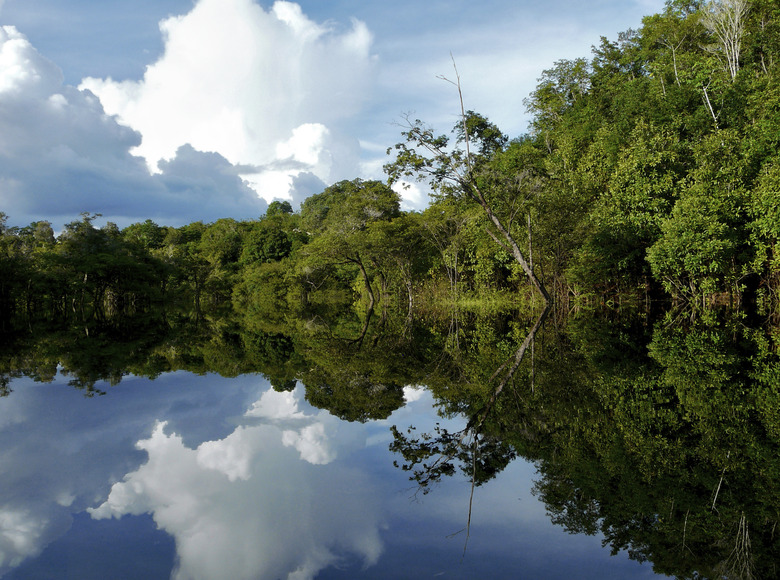Plants That Live In The Waters Of The Amazon Rivers
We may receive a commission on purchases made from links.
The Amazon River basin is home to extraordinary species diversity in both plants and animals. Amazon river plants can be found floating atop the water, thriving alongside shores or submerged in floodplain areas.
TL;DR (Too Long; Didn't Read)
Many Amazon river plants thrive in, along, or on top of the river and its tributaries. Some plants that live in the waters and floodplains of the Amazon River include giant water lilies, floating meadows, grasses, shrubs and short trees.
Dynamics of the Amazon River
Dynamics of the Amazon River
The immense Amazon River and its tributaries are fed by large amounts of rainfall each year. There is, however, a rainy season and a dry season. In the rainy season, the biome experiences seasonal flooding throughout the watershed. The water level can rise as much as 49 feet here, giving the landscape an infusion of water full of nutrients.
Plants abound in this ecoregion. Alongside and atop the river, plants, including trees, have adapted to the changeable environment. Floodplains that experience this dynamic are called várzeas.
Várzeas host a diverse landscape of flooded forests, grasslands and marshes. In addition to trees, grasses, shrubs and aquatic plants thrive here, all supporting a rich ecosystem with numerous animals depending on them for food and shelter. Many animals also choose to breed in the area to avoid predators found in drier areas.
Amazon River Plants
Amazon River Plants
In a várzea, plants adapt to remaining underwater for months at a time. Areas with permanently flooded swamp forests are called igapós.
Palms are common trees in this floodplain. Several species in the genus Geonoma thrive here. Other palm species include Mauritia flexuosa, Euterpe oleracea (the acai palm), Oenocarpus bacaba, Jessenia bataua, Socratea exorrhiza, Astrocaryum murumuru and numerous others.
Timber trees in the várzea include Calycophyllum brasiliensis, numerous species from the genus Ficus, Virola surinamensis, Pachira aquatica and Symphonia globulifera, to name a few. Lianas also thrive as Amazon river plants in the várzea regions; examples include Guatteria scandens, Landolphia paraensis and Strychnos blackii.
Floating Meadow Amazon River Plants
Floating Meadow Amazon River Plants
Part of the floodplains of the Amazon River host what are called floating meadows. These are expanses of both rooted and floating plants. They receive abundant sunlight for food and absorb nutrients from the floodwaters. The floodwaters are otherwise too muddy for plants underwater since they would not receive much sun.
Floating meadows are home to vines, shrubs and stunted trees. Some of them cover over a square mile. Among the denizens of the floating meadows are capybaras, which feed on grasses. Manatees also ply the waters and eat tremendous amounts of vegetation.
Perhaps the most fascinating plant of the floating meadow is the giant water lily (Victoria amazonica), which grows to a staggering four feet in diameter and holds significant weight. Its flowers reach temperatures about 15 degrees warmer than the outside air, making their sweet scent more volatile and attractive to scarab beetle pollinators. The plant gently traps the beetles, allowing them to be safe through the night and satiate on staminodes, and in the morning, it releases them to fly off and pollinate more giant water lilies. Their seeds settle in mud when floodwaters recede so they can grow more plants.
Challenges Facing Amazon River Basin Plants
Challenges Facing Amazon River Basin Plants
The unique aquatic dynamics of the Amazon Basin allow for specialized plants to thrive. Extraordinary animal diversity exists, with numerous birds, fish, rodents, deer, tapirs and other animals feeding on grasses, flowers and fruits.
As deforestation escalates, this unique biome faces daunting threats to maintain the delicate ecosystem that have grown over time. Logging has replaced much of the timber tree population of the Amazon Basin. Ranch cattle grazing the plants here compete directly with the native animals such as manatees and capybaras. Additional threats include depletion of fish and pollution from mining.
Since the várzea forests capture and recycle vital nutrients for this ecosystem, threats to the region from human development must be addressed. Learning more about the interactions between animals and plants in and along the Amazon River can help uncover ways to conserve this richly diverse region.
Cite This Article
MLA
Hermance, Dianne. "Plants That Live In The Waters Of The Amazon Rivers" sciencing.com, https://www.sciencing.com/plants-live-waters-amazon-rivers-6823575/. 30 September 2021.
APA
Hermance, Dianne. (2021, September 30). Plants That Live In The Waters Of The Amazon Rivers. sciencing.com. Retrieved from https://www.sciencing.com/plants-live-waters-amazon-rivers-6823575/
Chicago
Hermance, Dianne. Plants That Live In The Waters Of The Amazon Rivers last modified March 24, 2022. https://www.sciencing.com/plants-live-waters-amazon-rivers-6823575/
